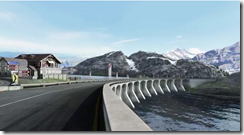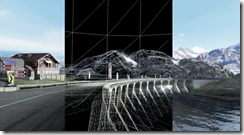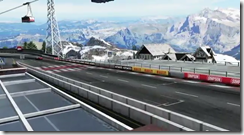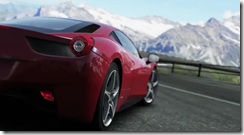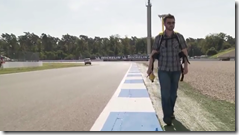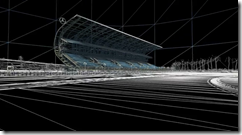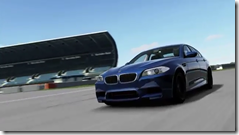In this second post about Forza Motorsport 4, I thought it’d be interesting to talk about how the team at Turn 10 Studios creates, and recreates, tracks for the game. I say “creates” because the tracks roster in Forza Motorsport 4 features a mixture of fictional tracks created from scratch as well as inch-perfect recreations of many of the world’s most well-known race tracks.
Let’s start with The Bernese Alps – a new fictional track that will appear in Forza Motorsport 4 – and the process that went in to creating it. Last summer, a group of Turn 10 developers travelled to the Alps of Switzerland and northern Italy, home of some of the world’s best driving roads (an assertion I agree with wholeheartedly, having recently visited the Swiss Alps—and driven a Tesla on those same roads).
The objective of this trip was to capture copious amounts of source material from the area—photographs, video and the like, which could be brought back to the studio and used as inspiration for creating Forza 4’s version of “the world’s best driving road.” Fictional tracks like The Bernese Alps allow Turn 10 to really flex their creative and technical muscles – and all of that creativity is rooted to reality. The team even goes so far as to create a fictional backstory for tracks like the Alps, working in bits of local history so that the race track feels authentic to the locale. During my visit to the Turn 10 studio, I saw the backstory for The Bernese Alps pinned to the wall – an A4 piece of paper with the story typed out and surrounded by photographs the team had taken of the area. The back story goes something like this –
the roads were originally built in 1936 as a network for supplies to build tunnels in to the region. When construction finishes, the roads fell in to disuse and were largely abandoned. Then in 1982, a group of developers bought the region to construct ski resorts and the area developed with features such as a dam etc. During the summer months, workers who came to service the resort began using the roads as unsanctioned race tracks, until 1986 when it was halted due to a fatal crash. Wind forward to 2001 and a wealthy investor arrives on the scene with a desire to build a race track on the peak that was like no other track in the world….
The story goes on but that’s the inspiration behind The Bernese Alps and I love the way it gives the track some soul. I was amazed by the level of detail the team applies to authentically create the experience. Swatches of building materials were in the studio to ensure trackside buildings were true to the colors and architecture of the region. If they’re paying that much interest in the buildings, it makes you confident that they’re paying even more interest in the track itself. Let’s switch to the recreation of Hockenheim to give you a sense of that process.
As with the Alps, a team of track artists travelled to the Hockenheimring, with the aim of recreating one of Germany’s most famous race tracks in as much detail as possible. To do that, they took something in the region of 10,000 digital photographs over the course of a few days. Turn 10 content director, John Wendl, had mentioned to me that they have a guy walk the track with a military-grade GPS to ensure that the track topology is captured in amazing detail. I didn’t actually believe him, but it’s true, they have a dude walk the track (several times) with a back mounted GPS system that has sub-centimeter accuracy on the horizontal plane and sub-feet on the vertical plane. These boys and girls take their work VERY seriously. If you come across a small bump in the track, or an unusual cambering, it’s because that’s exactly what it’s like at Hockenheim.
The team is always looking for more ways to inject authenticity and realism to the tracks in the game – for example, noting hard braking zones and ensuring there is rubber on the track in those places, just as there is in real life. They literally capture every square inch of the “ribbon” – a term I recently learned that refers to a particular layout of a track. And like The Bernese Alps, they look to recreate the surroundings in an authentic and realistic way. For Hockenheim, the Mercedes grandstand is an iconic part of the track, and is recreated in loving detail in the game. The team spends hours building structures, refining textures, and then mixing in “sparkle and polish” as they call it.
Just to be sure they have recreated a track in utmost detail, they then bring in professional drivers who are intimately familiar with these circuits and can offer the kind of feedback that can only be gleaned from hitting a bump a 150mph and telling you precisely what that feels like.
You can see Hockenheim in the video below and The Bernese Alps in the video above. In both videos, you’re seeing the result of some beautiful High Dynamic Range photography that the team used. That, coupled with new graphical techniques like Image Based Lighting, make the scenery in the game more life-like and the cars look brighter and more beautiful than ever before. Speaking of cars, the Bernese Alps is the first track you drive in Forza 4 — and you’ll be doing so in the 2010 Ferrari 458 Italia. For an entirely different challenge, I recommend taking a lap of Hockenheim in the 2012 BMW M5, the car featured on the cover of the Limited Collector’s Edition of Forza Motorsport 4. In fact, with months to go before the M5 is released to the market, Forza 4 is the ONLY place you can drive it!.
The tracks and the cars are the work of true artists of all types, and a team who is dedicated to celebrating cars and bringing you the best car game on the planet (IMHO). Roll on October 11th when we’ll get to drive all of these tracks.
….coming up Next week, a look at the cars of Forza 4.


